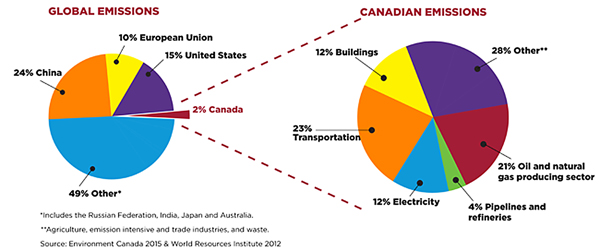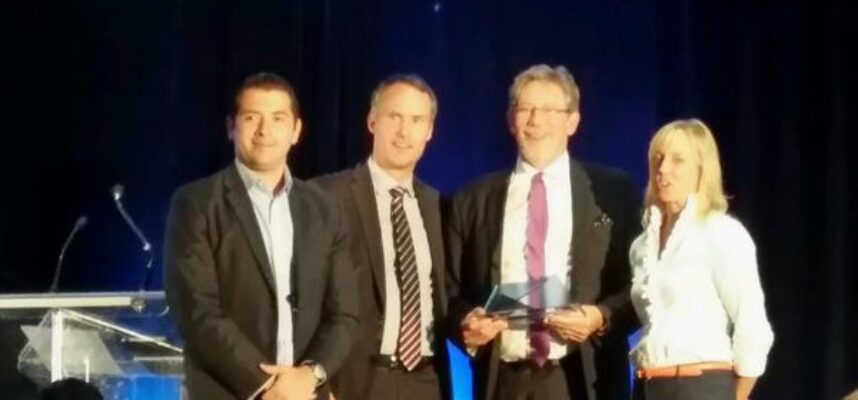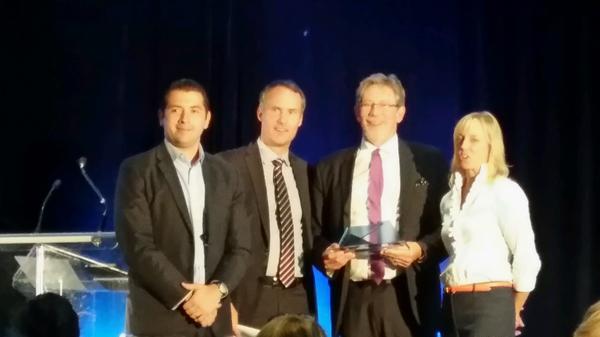Even though a life-long environmentalist, looking at the world through my children’s eyes drives home how pressing, and enormous, is the card we have dealt them. That legacy of unprecedented global climate change, leaves little choice between measures to achieve a rapid reversal of climate change or living with global apocalypse.
Personally, I vote for reversal, as one expects would most rational people. However, getting there requires a complete re-think of our lives, and our communities. In my daily life, I see huge opportunities.
 From Central to Middle of Nowhere (West Field)
From Central to Middle of Nowhere (West Field)
Having grown up in Listowel, Ontario, I recently attended the closing ceremony for the Central Public School which will be replaced by North Perth Westfield Elementary School – the difference in the names, previously “Central” to the new “West field” says it all and is illustrated in this map.
Although we all spent time reminiscing about memories and a proud history comprising at least 3 school buildings on the “Central” site, the issue I raise isn’t about heritage. The new school will necessitate a school bus ride for essentially all students. Unlike Central, where most students walked or biked to school, that option will be closed to all but a handful.

Beyond contributing to our climate change crisis, childhood obesity has doubled in the last 30 years (Reference: Centers for Disease Control), mostly as a result of less healthy eating and lack of physical activity. In an age where Physical Literacy and promoting active lifestyles has moved to the top of our agenda, school location should be seen as a contributor to the solution instead of being a major part of the culprit.
Near Elora, Centre Wellington District High School went through a similar “de-centralizing” exercise a few years ago. Groves Memorial Community Hospital is slated to move from its central location near downtown Fergus to a “green field” site (note the prevalence of the word “field” in these decisions) in land between the built up areas of Fergus and Elora. It is notable that the founder of Groves, none other than Abraham Groves was a social innovator of the previous century, who as a doctor pioneering surgical sterilization, did the first successful appendectomy in North America, created hydro power and phone service all to drive change in his home community. I am sure that if Groves were alive today, he would be promoting walkability and carbon footprint reduction.
Urban cores, and small town downtowns, continue to struggle with the appearance of big box stores on the periphery of communities. In addition to often devastating effect on once vibrant centres of community activity, this trend further exacerbates more driving and less walking. Not a good combination.
How do these choices in pubic infrastructure relate to the apocalyptic images of destruction at the top of this post? Climate change is very real with the effects more and more visible, and traumatic as each year passes. Events like the recent Fort McMurray fire, Goderich Tornado in 2011 and severe flooding in the UK can all be traced to the dramatic changes in global climate unfolding over the last few years. The steady, yet gradual increase in the earth’s temperature, leads to greater volatility and severity of weather events. We all know the depressing reality that, horrible as these are, things are going to get worse before they get better.
We used to call the buildup in Greenhouse Gas (GHG) emissions, driven by human activity powered by a reliance on fossil fuels such as oil and coal, Global Warming. It has been rebranded as climate change to reflect the reality that, although the average temperature increases, the main effect is to increase weather volatility. This volatility translates into extreme climate-related events with increasing frequency. Globally, climate change may lead to famines, mass migrations and wars of unprecedented scale and attendant misery.
Faced with this stark reality, you would expect a universal call for governments and public institutions to provide leadership to address climate change?
You would think not, but recent experiences have been been vividly frustrating in showing that, in fact, our public institutions have a long way to go. How are we, as citizens, able to do our part in these circumstances?

First it helps to break down such a massive problem into its constituent parts. To start, let’s quantify the effect that our transportation has on GHG reduction. From data compiled, ironically, by the Canadian Association of Petroleum Producers, transportation is the biggest single sector contributing to Greenhouse Gas emissions, closely followed by Oil and Natural Gas producing industries. Further, Canada has a much poorer record in this regard than other rich nations.
We live in an era when people care deeply about the well-being of future generations. Residential homebuyers are increasingly prioritizing Walkability Scores, which include access to nearby schools in home buying decisions. No generation is more concerned than the Millenials, who have internalized the legacy that climate change will seriously and adversely impact them during their lifetimes. A major way to reverse GHG emissions growth is to tackle personal transportation – to work, schools, hospitals, leisure and shopping.
Collectively, the “M.U.S.H. Sector” (publicly funded organizations like Municipalities, Universities, Schools and Hospitals) has a huge opportunity to take leadership in our current war on carbon. While we might believe that leadership must start at the top with government, without grassroots calls for change the political cost can be too high. (See: CBC News: Politicians Are Green Until They’re Intimidated by the Electoral Price) The challenge will be to empower ordinary folk to drive a climate positive future by taking such thinking from the realm of environmentalists and making it mainstream.
We urgently need an optimistic call to action that citizens can easily embrace. I am working with people that the Elora Environment Centre, an NGO leading innovation and action on the environment, to repackage the Climate Change narrative from one that leaves people powerless, frustrated and even guilt-ridden. We aim to find ways to re-boot the climate change narrative, and unleash a crowdsourced solution coming from the grass roots. Stay tuned. Our planet and our children are counting on it!
 In our 3rd year, some exciting changes are afoot as we see our vision for the Prize unfold.
In our 3rd year, some exciting changes are afoot as we see our vision for the Prize unfold. To accompany the design, Chris selected the recently designed LL Circular font by Laurenz Brunner from Lineto in Switzerland. The font manages to be “geometric without being cold” and timeless while modern.
To accompany the design, Chris selected the recently designed LL Circular font by Laurenz Brunner from Lineto in Switzerland. The font manages to be “geometric without being cold” and timeless while modern.



 Mobile user experience has, as it were, come up from the Farm and we are now definitely in Paree. It’s hard to imagine how things could get much better, yet an even more exciting future in mobile will undoubtedly unfold. The pace of change has been almost mind boggling, with Android appearing to move almost twice as fast as iOS, the more proprietary Apple platform running iPhone and iPad.
Mobile user experience has, as it were, come up from the Farm and we are now definitely in Paree. It’s hard to imagine how things could get much better, yet an even more exciting future in mobile will undoubtedly unfold. The pace of change has been almost mind boggling, with Android appearing to move almost twice as fast as iOS, the more proprietary Apple platform running iPhone and iPad.



18 Sep 2016
0 CommentsWho Will Lead Our Institutions’ Response to Climate Change
Even though a life-long environmentalist, looking at the world through my children’s eyes drives home how pressing, and enormous, is the card we have dealt them. That legacy of unprecedented global climate change, leaves little choice between measures to achieve a rapid reversal of climate change or living with global apocalypse.
Personally, I vote for reversal, as one expects would most rational people. However, getting there requires a complete re-think of our lives, and our communities. In my daily life, I see huge opportunities.
Having grown up in Listowel, Ontario, I recently attended the closing ceremony for the Central Public School which will be replaced by North Perth Westfield Elementary School – the difference in the names, previously “Central” to the new “West field” says it all and is illustrated in this map.
Although we all spent time reminiscing about memories and a proud history comprising at least 3 school buildings on the “Central” site, the issue I raise isn’t about heritage. The new school will necessitate a school bus ride for essentially all students. Unlike Central, where most students walked or biked to school, that option will be closed to all but a handful.
Beyond contributing to our climate change crisis, childhood obesity has doubled in the last 30 years (Reference: Centers for Disease Control), mostly as a result of less healthy eating and lack of physical activity. In an age where Physical Literacy and promoting active lifestyles has moved to the top of our agenda, school location should be seen as a contributor to the solution instead of being a major part of the culprit.
Near Elora, Centre Wellington District High School went through a similar “de-centralizing” exercise a few years ago. Groves Memorial Community Hospital is slated to move from its central location near downtown Fergus to a “green field” site (note the prevalence of the word “field” in these decisions) in land between the built up areas of Fergus and Elora. It is notable that the founder of Groves, none other than Abraham Groves was a social innovator of the previous century, who as a doctor pioneering surgical sterilization, did the first successful appendectomy in North America, created hydro power and phone service all to drive change in his home community. I am sure that if Groves were alive today, he would be promoting walkability and carbon footprint reduction.
Urban cores, and small town downtowns, continue to struggle with the appearance of big box stores on the periphery of communities. In addition to often devastating effect on once vibrant centres of community activity, this trend further exacerbates more driving and less walking. Not a good combination.
How do these choices in pubic infrastructure relate to the apocalyptic images of destruction at the top of this post? Climate change is very real with the effects more and more visible, and traumatic as each year passes. Events like the recent Fort McMurray fire, Goderich Tornado in 2011 and severe flooding in the UK can all be traced to the dramatic changes in global climate unfolding over the last few years. The steady, yet gradual increase in the earth’s temperature, leads to greater volatility and severity of weather events. We all know the depressing reality that, horrible as these are, things are going to get worse before they get better.
We used to call the buildup in Greenhouse Gas (GHG) emissions, driven by human activity powered by a reliance on fossil fuels such as oil and coal, Global Warming. It has been rebranded as climate change to reflect the reality that, although the average temperature increases, the main effect is to increase weather volatility. This volatility translates into extreme climate-related events with increasing frequency. Globally, climate change may lead to famines, mass migrations and wars of unprecedented scale and attendant misery.
Faced with this stark reality, you would expect a universal call for governments and public institutions to provide leadership to address climate change?
You would think not, but recent experiences have been been vividly frustrating in showing that, in fact, our public institutions have a long way to go. How are we, as citizens, able to do our part in these circumstances?
First it helps to break down such a massive problem into its constituent parts. To start, let’s quantify the effect that our transportation has on GHG reduction. From data compiled, ironically, by the Canadian Association of Petroleum Producers, transportation is the biggest single sector contributing to Greenhouse Gas emissions, closely followed by Oil and Natural Gas producing industries. Further, Canada has a much poorer record in this regard than other rich nations.
We live in an era when people care deeply about the well-being of future generations. Residential homebuyers are increasingly prioritizing Walkability Scores, which include access to nearby schools in home buying decisions. No generation is more concerned than the Millenials, who have internalized the legacy that climate change will seriously and adversely impact them during their lifetimes. A major way to reverse GHG emissions growth is to tackle personal transportation – to work, schools, hospitals, leisure and shopping.
Collectively, the “M.U.S.H. Sector” (publicly funded organizations like Municipalities, Universities, Schools and Hospitals) has a huge opportunity to take leadership in our current war on carbon. While we might believe that leadership must start at the top with government, without grassroots calls for change the political cost can be too high. (See: CBC News: Politicians Are Green Until They’re Intimidated by the Electoral Price) The challenge will be to empower ordinary folk to drive a climate positive future by taking such thinking from the realm of environmentalists and making it mainstream.
We urgently need an optimistic call to action that citizens can easily embrace. I am working with people that the Elora Environment Centre, an NGO leading innovation and action on the environment, to repackage the Climate Change narrative from one that leaves people powerless, frustrated and even guilt-ridden. We aim to find ways to re-boot the climate change narrative, and unleash a crowdsourced solution coming from the grass roots. Stay tuned. Our planet and our children are counting on it!